Paintings in Parliament House
Paintings in Parliament House
Paintings in Parliament House
You also want an ePaper? Increase the reach of your titles
YUMPU automatically turns print PDFs into web optimized ePapers that Google loves.
<strong>Pa<strong>in</strong>t<strong>in</strong>gs</strong><br />
In <strong>Parliament</strong> <strong>House</strong><br />
As one enters the <strong>Parliament</strong> <strong>House</strong>, one is<br />
fasc<strong>in</strong>ated by a row of beautiful pa<strong>in</strong>t<strong>in</strong>gs<br />
adorn<strong>in</strong>g the walls of the outer circular corridor<br />
on the ground floor. The pa<strong>in</strong>t<strong>in</strong>gs are the works<br />
of em<strong>in</strong>ent artists of India, depict<strong>in</strong>g scenes from<br />
the long history of this country right from the<br />
Vedic age down the British period, culm<strong>in</strong>at<strong>in</strong>g<br />
<strong>in</strong> the atta<strong>in</strong>ment of <strong>in</strong>dependence <strong>in</strong> 1947.<br />
The practice <strong>in</strong> India of decorat<strong>in</strong>g public places,<br />
temples and palaces etc., with pa<strong>in</strong>t<strong>in</strong>gs and<br />
murals has come down to us s<strong>in</strong>ce time<br />
immemorial. These pieces of art are symbolic<br />
of the life, culture and traditions of the people of<br />
the contemporaneous periods. To us now, they are<br />
rem<strong>in</strong>iscent of the great civilizations and empires<br />
that flourished <strong>in</strong> India <strong>in</strong> the past and of the<br />
great k<strong>in</strong>gs, warriors and sa<strong>in</strong>ts who by their<br />
efforts glorified this land of ours. The caves of<br />
Ajanta, Ellora and Elephanta are vivid rem<strong>in</strong>ders of<br />
great art that flourished centuries ago.<br />
It was natural, therefore, that the architects of<br />
modern India should have thought it fit to<br />
decorate the modern temple of democracy, i.e.<br />
the <strong>Parliament</strong> <strong>House</strong>, with pa<strong>in</strong>t<strong>in</strong>gs depict<strong>in</strong>g<br />
great moments <strong>in</strong> the history of this country<br />
and to try to revive <strong>in</strong> some measure the glory<br />
that was 'India'. The idea was first conceived<br />
by the late Shri G.V. Mavalankar, the first<br />
Speaker of Lok Sabha. In 1951, a Plann<strong>in</strong>g<br />
Committee was appo<strong>in</strong>ted, consist<strong>in</strong>g of<br />
prom<strong>in</strong>ent Members of <strong>Parliament</strong>, em<strong>in</strong>ent<br />
scholars, archaeologists, historians with the<br />
Speaker (Shri G.V. Mavalankar) as Chairman. The<br />
Committee drew up a detailed plan to decorate<br />
the corridor on the ground floor of the<br />
<strong>Parliament</strong> <strong>House</strong> with 125 panels (size 11'.9" x<br />
4'.11/2'') and 46 motifs, at an estimated cost of<br />
Rs. 3 lakhs. Accord<strong>in</strong>g to revised plan the<br />
corridor on Ground Floor of the <strong>Parliament</strong> <strong>House</strong><br />
will be decorated with 59 Panels.<br />
In order to execute the plan, an Artists Sub-<br />
Committee consist<strong>in</strong>g of well-known artists,<br />
historians, archaeologists and archaeological<br />
chemists was appo<strong>in</strong>ted <strong>in</strong> 1954. This<br />
Sub-Committee laid down a detailed and<br />
systematic procedure for gett<strong>in</strong>g the panels<br />
pa<strong>in</strong>ted by selected artists <strong>in</strong> the country.<br />
So far, 58 panels have been completed and<br />
displayed <strong>in</strong> the outer corridor on the ground



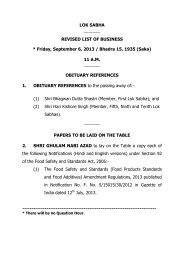
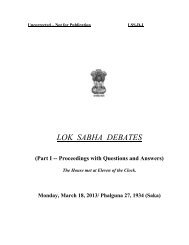

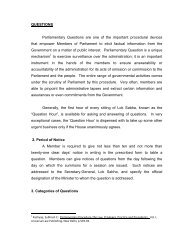
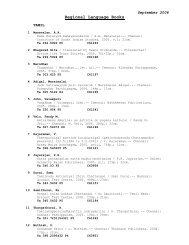

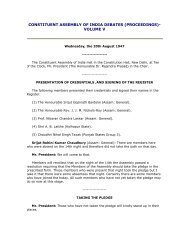
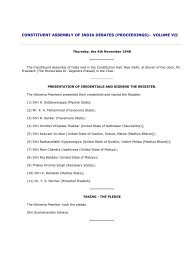
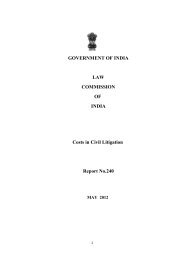
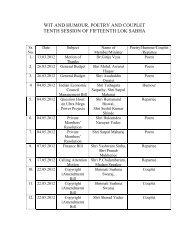
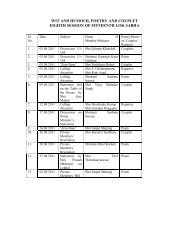

![gÉÉŌ A.]ÉŌ. xÉÉxÉÉ](https://img.yumpu.com/8015720/1/190x245/geeo-aeo-xeexee.jpg?quality=85)
